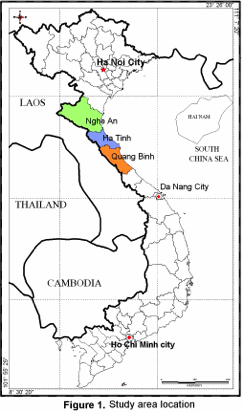- Home
- Introduction
- General information
- Project Objectives
- Expected Outputs
- Project plan
- Project Documents
- Project progess
- Literatures/Documents
- Weather Forecast
- Participatory Infor. System (PIS)
- Publications
- Vietnamese Climate Atlas
- News & Events
- Fieldtrip photos and others
- Project's Researchers
- CAREs
- Contact/Feedback
Online visitors
Online visitors: 21 Members: 0 .Total pageviews 6842016
Introduction
Climate change (CC), especially through extreme climate events (ECEs) is currently a major threat to Vietnam’s socio-economic development (Chaudhry and Ruysschaert 2007), with potentially heavy impact on particularly the livelihood security of the poorest rural population segments. The Vietnamese government has established the National Target Program to Respond to Climate Change (NTP) (MONRE 2008), with the aim of increasing resilience and reducing vulnerability to CC. The Ministry of Agriculture and Rural Development (MARD) has also established the Action Plan Framework for Adaptation and Mitigation of CC (APFAMCC) in the Agriculture and Rural Development Sector for 2008-2020. The international community is assisting the Vietnamese government in CC adaptation and mitigation activities for sustainable local development in especially the poor and marginalized regions of Vietnam.
Nghe An, Ha Tinh and Quang Binh provinces (NHQ) have a population of about 5.2 million inhabitants of which 70% are living in the coastal and lowland areas (CLLA). Most of these inhabitants somehow depend on revenues from agricultural and aquacultural sectors. Due to the geographical and socio-economic conditions, NHQ remain the second lowest GDP-per-capita zone in Vietnam. With about 350 km of coast line open to the East Sea (Fig. 1), CLLA of these provinces is inherently affected by severe disasters such as typhoons, floods, droughts, inundation and salinity intrusion. Only during 2010, the NHQ coastal zone suffered two opposite events: a long drought in June-July and two consecutive strong floods in October. The hot spell from 12 to 20 June caused the loss of about 30,000 ha of the Summer-Autumn paddy. In October 2010 these provinces were strongly hit by two consecutive floods caused by the heavy rainfall (800–1,658 mm) and causing considerable damages over a huge territory. Over 155,000 houses were submerged, thousands of people have again fled their homes in floods and the three provinces had a known death toll of 66 people (UNDP 2010).

Obviously, it is important that the consequences of CC should not lead already marginalized sections of communities into further deprivation (Denton 2002), and the best long-term adaptation measure for the most vulnerable communities is to increase their capacity for disaster preparedness (Chaudhry and Ruysschaert 2007, Snidvongs 2003), but also to promote the sustainable use of water resources in their economy. In a context where agriculture and aquaculture, the two key production systems of these provinces (contributing up to 35.5% of total GDP), are still strongly based on water resources (both in terms of quantity and quality), the previous experiences accumulated in coping with disasters and the indigenous knowledge of the coastal and lowland communities have played a decisive role in maintaining livelihoods until now. However, the impact of water disaster (WD) induced by CC is likely to exacerbate their vulnerability. It is therefore important to examine which kind of indigenous knowledge accumulated from generation to generation may be replicable in this new context. Due to their complex and interdisciplinary nature, climate change research and adaptation programs in Vietnam are facing serious challenges such as: the lack of a scientifically well-argued background for understanding the complex interaction between nature and society under the context of climate change; qualified human resources; inter-sector collaboration; and especially, the lack of spatial data infrastructures (SDI) and efficient tools to be applied in the local policy making processes like Participatory Geographical Information System.
Thus, in this project, three conceptual questions are raised:
1) What can the cross-cutting research contribute to reduce the vulnerability and improve the resilience capacity of the coastal and lowland communities in NHQ in particular and in Vietnam in general?
2) How to get scientists, policy makers and local community representatives involved into an action plan to reduce the vulnerability to CC impact in NHQ coastal and lowland context? And
3) How to translate multidisciplinary information into a simplified, accessible and usable format for community and into efficient tools for vulnerability reduction (VR) and improving community resilience capacity in NHQ?
Based on the conceptual questions mentioned above, the project will try to clarify the interaction between the three co-beneficiaries of Community, Local Authority and Scientist by justifying the following hypotheses/assumptions:
1) Water related extreme events will be intensified by CC and have critical negative impacts on the production systems of agriculture and aquaculture in NHQ. A solid understanding of these impacts will, if effectively communicated, contribute to minimizing the vulnerability and increasing the resilience capacity of the coastal and lowland communities in NHQ.
2) There is a local demand for a Participatory Information System (PIS) that integrates the multi- and inter-disciplinary scientific and technological knowledge with indigenous experiences. Such integration can provide an effective tool for increasing community resilience towards CC impacts, and facilitating local sustainable development practices by means of mass participation.
3) The impact of water related extreme events may be born disproportionally by vulnerable groups in terms of loss of livelihoods, assets and employment. Such groups may be identified both socially and spatially.
4) The impacts of CC should be analysed in a broader, interacting relationship with other socio-economic and environmental factors. Thus CC adaptation efforts need to be holistic in orientation, including evaluation of conventional resource management practices, and lend support to sound environmental management (e.g. Berkes et. al. 2008).


